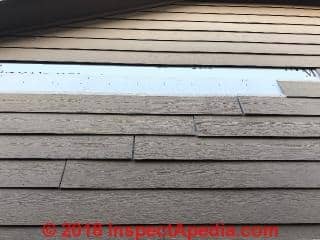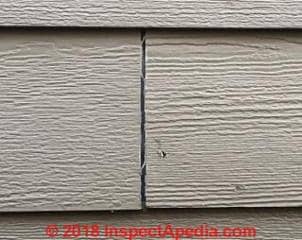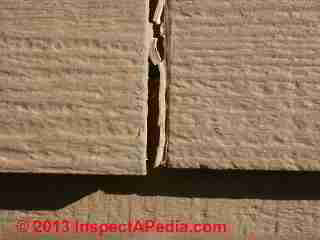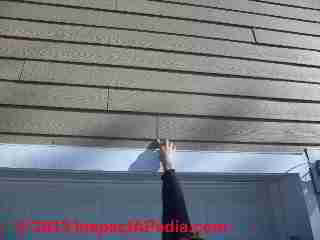 Fiber Cement Siding Gaps
Fiber Cement Siding Gaps
How to diagnose the cause & choose a cure for fiber cement lap siding butt joint & trim joint gaps
- POST a QUESTION or COMMENT about the cause & cure of butt joint gaps in fiber-cement siding & about fiber cement siding installation
Gaps in fiber cement siding: clearance gaps, how big should they be;
where should there be no gap (butt joints). What are the causes of un-wanted gaps at the butt joints in fiber cement lap siding? How are such gaps prevented and if they have already occurred, how are they best repaired?
This article series includes field reports of fiber cement board lap siding butt joint gap problems, fiber cement moisture problems, and other fiber cement lap siding installation or in-service defects, their diagnosis & repair.
We include diagnostic inspection photos and text explain how to recognize, diagnose, and cure this problem.
InspectAPedia tolerates no conflicts of interest. We have no relationship with advertisers, products, or services discussed at this website.
Fiber Cement Lap Siding End Clearance & Butt Joint Gaps
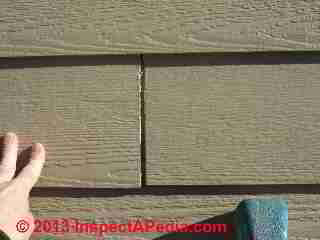 Fiber Cement siding installation butt joint gap complaints, cause, effects, cures
Fiber Cement siding installation butt joint gap complaints, cause, effects, cures
By 2005 we had found a few quotes from building owners complaining of apparent shrinkage in James HardiePlank siding, with gaps of as much as 1/4" opening between the butt joints of boards or between siding boards and abutting vertical trim.
[Click to enlarge any image]
Complaints about gaps, loose and curling siding and even siding loss continued to be reported in 2018.
"Anybody had their HardiePlank shrink? Ours developed about 1/4 inches gaps between the boards, which needed to be caulked."
"It [James HardiePlank Siding] was installed in August of 97 and there is some shrinkage but only 1/8 inch gap or so in some seams." [3]
And HardiePlank is not the only fiber (wood) cement board siding product with shrinkage questions reported in 2008:
" We have CT fiber cement board [CertainTeed Weatherboard™fiber cement siding] on our home. We built our house in 2004 and the siding is shrinking and warping and in the upper Midwest, this is a big problem for CT.
I believe these problems may have put our builder out of business as he has been trying to make repairs with no or little assistance from CT. "
... and ...
"I've seen it shrink, bow, peel, and pop nails within a year." [4]
We had winds knock some siding off and it is loose. House is almost 10 years old. We were additionally told it is our responsibility to recaulk the joints every year, but from what I read here you shouldn’t?
We were told by 4 different contractors that our siding wasn’t installed properly, but the builder just came to look at it and said it was installed per manufactures instructions. We were told it was Hardiboard when we bought the house, but the builder says CertainTeed now (even though I don’t think it looks like it from your photos). It was nailed into particle board, I believe, but seems to have been nailed willy, nilly. - Anonymous by private email 2018/03/07-08
Our fiber cement lap siding photo (above left) illustrates the butt-joint gap problem. On this building we measured gaps between siding boards of as much as 5/16" at butt joints.
Make Sure You Have Correctly Identified the Siding Material and Brand
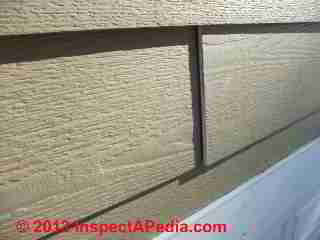
Watch out: informal surveys we performed in 2012 and 2013 in which we reviewed the top 20 website discussing fiber cement siding failures or performance issues we found a lot of confusion: hardboard siding was mistaken for fiber cement siding, and people were also inclined to assign a manufacturer's name to a product before it was positively identified.
In the siding gap complaint we investigated and documented here the original property owner thought that they had contracted for the installation of HardiePlank® fiber cement lap siding.
We found that another "Brand X" product had been installed instead. The owners did not get what they paid for in both the product itself and in the quality of its installation.
To identify fiber cement siding products as CertainTeed, Hardieplank or Brand "X" Fiber Cement Siding please see SIDING, FIBER CEMENT IDENTIFICATION .
Opinions about the cause of fiber cement board siding gaps and proper cures vary but making sure that the fiber cement siding is dry at delivery & proper siding storage prior to installation are important.
A few sources assert that HardiePlank and similar products do not warp or shrink, [7] leaving us surprised when we first heard of shrinkage complaints with these products back in 2005.
But as we document below, currently the company warns that if the product is not stored properly (flat, keep dry) prior to installation, if the material becomes wet or saturated the result may be shrinkage at the butt joints.
Therefore it is most likely that HardiePlank lap siding shrinkage gaps appearing at butt joints or possibly at vertical trim joints (those are usually caulked) are most likely due to the installation of siding that was at too high a moisture content at the time of installation.
Where did this "too wet" or "too moist" fiber cement problem originate? Before investigating the topic in depth we thought that the most common source of too-wet fiber cement siding was improper storage and handling prior to installation, exposing the siding to wet or saturating conditions.
Below: three more FC siding loose, gaps, mis-nailing photos from two different buildings at different locations.
Above: siding gaps and siding falling-off of a home where FC siding appears to have been improperly-nailed. The closeup from the same building's fiber cement siding shows a caulked and separated FC butt joint and face-nailing of the boards. - Anonymous by private email 2018/03/08
[Click to enlarge any image]
Other factors in gap formation in fiber cement siding might include a combination of coating inadequacy, nailing defects and weather exposure.
Below: besides shrinkage gaps shown above, still another readers' photo below show more face-nailed and loose fiber cement siding boards, board butt joints not staggered up the wall, and curling up FC siding board ends. - Anonymous by private email 2018/03/05
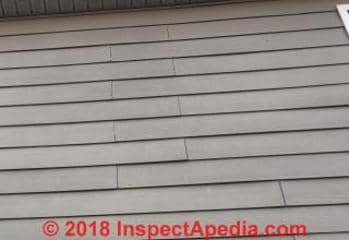 But we have also observed fiber cement siding that was delivered to the job wet from the supplier, even in cases where the product was still in the original, un-damaged factory-sealed plastic protective wrapping.
But we have also observed fiber cement siding that was delivered to the job wet from the supplier, even in cases where the product was still in the original, un-damaged factory-sealed plastic protective wrapping.
Where we observe an extensive problem with lap siding gaps in fiber-cement products it comes as no surprise that we are likely to find additional installation mistakes, errors, or omissions as well.
In several of our fiber cement siding photos above you can see that the siding was inadequately nailed and is quite loose.
On all of these buildings, some siding boards not only were lifting away from the structure at butt joints, we also found that some boards were misaligned by more than 1/4" vertically, giving a stair-step misalignment at the butt joints.
We trust the company's experience, opinions and advice about their product, but not everyone agrees, as this carpenter commented as shown just below:
"Both products [Hardieplank and CertainTeed fiber cement board lap siding] differ only slightly, but each does have there [their] molecular stamp.
People who are having problems with it are not installing it right. There is absolutely no way it should be warping, if it is installed right. The molecular make up won't allow it to shrink and swell as much as people are supposedly experiencing.
If you stick with the install specs, then problems will not occur. Spacing and gaps, nailing and nails, what kind and how you caulk, paint base and what you paint, vapor retarder vs barrier, sub-sheathing, everything that is included in the specs should be followed. ... They give us carpenters a bad name." [4]
Really? we disagree with the OPINION expressed just above at a DIY website - that installer's comments disagree with field reports, actual field experience, and consumer as well as installer observations as well as independent expert research on this topic.
Actual Causes of Shrinkage Gaps in Fiber Cement Siding Products
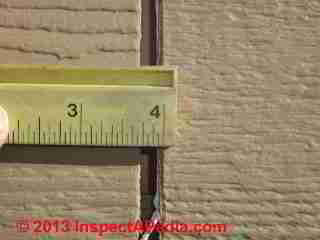
Our close-up photo of a butt joint gap in this fiber cement lap siding was made to document the width of the shrinkage gap.
But more information is at hand: the installers failed to install the recommended backer flashing / weatherproofing at any of the butt joints that we examined.
Observation of the location and size of gaps; normally shrinkage in a fiber cement siding product (or expansion) is uniform along the length of individual pieces.
Sources of Gaps in Fiber Cement Siding Products
- Product shrinkage: installation of fiber cement board or panels that are wet or at high moisture content, followed by subsequent shrinkage due to air drying or a combination of air drying and warming from sun exposure.
This is the principal cause of gaps in FC siding such as seen in the photograph at above-left. - Product compression followed by product shrinkage: the absorption of moisture into fiber cement wall calddings, panels or boards, particularly through the product's hidden or wall side from leaks into the wall cladding system and possibly exacerbated by a secondary factor of thermal expansion may cause the product to expand, crushing tight butt joints that may appear as small openings later as the product dries and cools.
However in my [DF] opinion this compression damage effect is likely to be less observable than product shrinkage, at least for lap siding fiber cement boards that were installed wet.
Where fiber cement product expansion and compression has been reported at problematic levels (Doggett 2012), there is visible edge damage and curling of large fiber cement panels or long fiber cement boards that were installed tightly -butted or without adequate clearance space for a flexible sealant.
Coefficients of Thermal & Moisture Expansion for Fiber Cement Products
There are two basic expansion/shrinkage forces in operation in fibre cement products: temperature and moisture. Of these, moisture is generally more significant.
Thermal expansion of fiber cement siding: Doggett (2012) places the coefficient of thermal expansion (COTE) for fiber cement products at 3.6-10 to 7.6-10 in/ in degree F, giving a linear expansion of less than 0.08" over ten feet of material.
Moisture expansion of fiber cement siding: Similarly the same author reports moisture-induced movement of 0.05% to 0.098% of the material length based on ASTM C1185 (which he criticizes as inadequatel because of the possibility of significantly more back-side absorbed moisture than anticipated by theh standard).
Still this moisture-induced expansion can generate 0.12" of expansion over 10 feet.
Moisture expansion + thermal expansion if occurring simultaneously can produce movement exceeding the 1/8" movement standard. Doggett also notes that panel edge swelling (perhaps where edges are left un-sealed at cuts or where the edge seal has failed) can exceed 1.5% of the material thickness at saturation.
He also points out that a 1/8" gap left between FC siding products is too small to accomodate proper joint design for effective sealants that specifies a minimum sealant (caulk) width of 1/4" and a width to depth ratio of 2:1.
Really? For 1/2" thick Nichiha Fiber Cement siding boards the width would thus be calculated at one inch! Perhaps we've misundersdtood the author.
Doggett makes this important observation about the ASTM standard used for determining moisture movement in fiber cement siding products:
For the purpose of determining moisture movement, ASTM C1185 stipulates specimen exposures to practical equilibrium at a relative humidity range of 30-90% and a temperature of 73F (±4F).
Moisture movement testing is performed independently of water tightness
. In other words, the results assume that bulk water is not introduced and that bulk water is not transferred to the back side of the panel.
We argue that such assumptions are flawed and that joint performance should anticipate bulk water wetting to the back side. - Doggett (2012)
Comparison of the moisture-related expansion of wood with fiber cement
While expansion-compression is a significant factor in wood flooring that was installed dry then soaked-wet to cause swelling, the coefficients of expansion for wet wood are notably greater than for fiber cement siding, with wood moisture caused swelling varying by species and direction of wood grain.
While there is wide variation among wood species and among individual boards, Simpson & TenWolde put the shrinkage percent from green to oven-dry moisture content in Coastal Douglas Fir at 1.8% radial, 7.6% tangential, and 12.4% volumetric. - (Simpson 1999 US FPL)
References for Expansion Properties & Other Characteristics of Fiber Cement Siding
- EXPANSION CHARACTERISTICS OF JAMES HARDIE® SIDING PRODUCTS, James Hardie Technical Bulletin #8, [PDF] (March 2012),
Website: www.jhameshardie.com, Tel: 1-866-442-7343, retrieved 2017/09/13, original source: https://www.jameshardie.com/JamesHardieMainSite/media/Site-Documents/TechnicalBulletins/8-expansion-characteristics.pdf
Other technical bulletins provided by the company can be found at https://www.jameshardie.com/product-support/resource-center/technical-bulletins
Excerpts:
Fiber cement (complying with ASTM C1186), as do all building materials, expands and contracts with changes in relative humidity and temperature. James Hardie recommends designing for this type of movement on buildings with long runs of continuous siding.
Coefficient of Thermal Expansion (COTE) per ASTM E228 is:
Longitudinal COTE = 6.7X10E-6 in/in ° F
Transverse COTE = 7.65X10E-6 in/in ° F
Moisture movement per ASTM C1185 (30% RH to 90% RH) is: 0.05% of length. - CERTAINTEED MASTER CRAFTSMAN Education & Development Program, VINYL & POLYMER SIDING [PDF], CertainTeed Corporation, retrieved 2017/09/13, original source: https://www.certainteed.com/resources/217.pdf
Excerpt:
Although fiber cement has been used as a building material in Europe for nearly 100 years, fiber cement siding is a relative newcomer to the United States. Composed of Portland cement, pulp fiber, sand, and special additives, fiber cement is manufactured as a smooth sheet and then embossed with a wood grain or stucco finish.
Fiber cement is an absorptive cladding that can hold moisture, creating the potential for penetration leading to rot, mold and/or poor indoor air quality. It is also susceptible to freeze/thaw complications.
Appearance of Gaps in Fiber Cement Siding Products
The following conditions or details may affect how shrinkage gaps may appear in siding products:
- Product Moisture Levels at Time of FC Siding Installation: Product delivery & storage: look for photographs taken during building construction for possible evidence of damage at the time of delivery, improper storage (exposure to weather) as well as for the general condition of the siding product and its coating. The company's installation instructions include the following instruction and comment:
Store flat and keep dry and covered prior to installation. Installing siding wet or saturated may result in shrinkage at butt joints. [15]
Watch out: We have seen serious shrinkage in both counterfeit fiber cement siding and right from the factory James Hardieplank® fiber cement siding that we inspected and tested in 2012 and 2013 - DJF. Following the removal of "counterfeit siding" that had shrunk, disappointing the building owners, the contractor, Galow Homes, ordered new Hardieplank siding from a local building supplier.
As we document at SIDING, FIBER CEMENT MOISTURE LEVELS, new FC siding arrived visibly wet (inside its plastic wrapping) from the supplier and from the manufacturer. And as we also explain there, the definition of "wet or saturated" siding mentioned above is not given in the product literature nor easily obtained from at least some fiber cement manufacturers.
Our siding close-up photo at left illustrates what may be another clue in the history of this failed (unidentified brand) fiber cement installation. We can see a hard-dried layer of caulk that was a bit under 1/8" wide inside of the now wide-open butt joint between two siding boards.
We suspected that someone noticed these shrinkage gaps in the building siding earlier in the life of the installation, possibly very soon after installation or even during installation as the probably-wet siding boards dried and began to shrink. Someone attempted a cosmetic repair.
Unfortunately the repair was performed before all of the siding shrinkage had taken place. That this siding installation continued to shrink after the caulk application is evident by this image.
Also notice that the boards are misaligned vertically as well. All of these clues suggest a hasty installation by un-trained and un-supervised installers. More examples of siding installation errors are included below.
- Coating: what type of paint was used on the product? Was it back-primed (if recommended) or factory primed? What is the moisture resistance of the coating used? Do not use stain on James Hardie products. The siding should be painted (use an acrylic paint) within 180 days for primed products or within 90 days for unprimed products. Do not use stain; do not use oil/alkyd-based paints;
The company warns against painting when the surfaces are wet - a topic that we elaborate ad nauseam at PAINTING MISTAKES. The company provides special touch-up coatings for ColorPlus products. - Original installation & nailing: was the siding installed according to the product specifications for type of nail, nail spacing, overlap, back priming, butt joint and trim joint end priming & caulking? See the product's caulking, nailing, flashing, installation details provided by James Hardie and excerpted in our notes below.
Except in high wind areas, the product is installed using blind nailing (nails at the top of each siding course are covered by the succeeding course). Nails (or screws for metal stud applications) must be corrosion resistant, galvanized or stainless steel. Hot-dipped galvanized fasteners or stainless steel (near salt or ocean areas) are recommended.
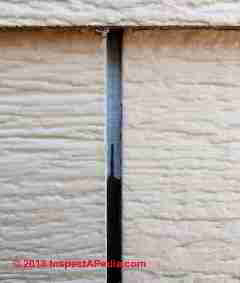
- Sealing / caulking /flashing: how were butt joints and end joints treated, flashed, caulked?
Actually at lap siding butt joints caulk should not have been used; back flashing or H-flashing are required for some fiber cement siding products and recommended for most others. Our photo (left) from this same ugly siding job shows the building paper exposed - no flashing, just leaks in this wall.
Caulking is required at certain other joints such as at vertical trim abutments.
Was the proper type of caulk used? The company recommends latex caulk or "an elastomeric joint sealant complying with ASTM C920 Grade NS, Class 25 or higher or a Latex Joint Sealant complying with ASTM C835.
[Some caulks such as OSI Quad do not allow joint tooling.] Non factory-cut edges should terminate into trim where possible, and should be caulked; where not abutting vertical trim non factory-cut edges should be sealed using an edge coated provided by the manufacturer.
Siding butt joint treatment: both CertainTeed and JamesHardie (as of September 2008) have made clear that siding butt joint gaps should never be made [that is: do not deliberately leave butt joint gaps in fiber cement lap siding]and that they do not recommend caulking field-cut butt joints in their board type fiber cement siding products.
JamesHardie requires the use of joint flashing behind the siding field butt joint for HardiePlank lap siding with ColorPlus technology (factory coated in a finish-color) and continues that this is the preferred method when installing JamesHardie HardiePlank lap siding.[5][5a][5b][12][12b]
Quoting from JamesHardie
The use of caulk at field butt joints is a maintenance item for the homeowner, aesthetically compromises
the finish look and is recommended against by some caulk manufacturers.[12b]
2006 International Building Code citation on siding flashing & sealing:
1405.17.2 Horizontal lap siding. Lap siding shall be lapped a minimum of 1 ¼ inches (32 mm) and shall have the ends sealed with caulking, covered with an H-section joint cover or located over a strip of flashing.
Manufacturers (Certainteed for example) recommend sealing the cut-ends of fiber cement siding with 100% acrylic latex primer or paint.
Back flashing or sliding H-type flashing are recommended. Details about siding butt joint flashing & caulking as well as other fiber cement siding clearances, gaps, and caulk specifications are at SIDING, FIBER CEMENT GAP & CAULK SPECS - Weather exposure: how does the appearance of gaps relate to weather, sun, and wind exposure?
Reader Question: 1/4-inch Gaps at Butt Joints in a CertainTeed siding installation? My contractor says it's factory Spec
I had CertainTeed factory painted fibre cement siding installed on my new home last year. The installer, contrary to the CertainTeed installation instructions, left a 1/8" gap at all butt joints. He now maintains that CertainTeed and other contractors state that a 1\4" gap at butt joints is acceptable.
I cannot find any documentation to support this, and I maintain that the requirement by CertainTeed to not leave a gap of any kind is to greatly minimize any shrinkage that might subsequently occur at the butt joints.
Could you help me with this? Thank you. - M.D 4/11/13
Reply: Certainteed emphatically advises against any gaps at their fiber cement siding butt joints; caulking is also not recommended. Current (2014) advice is "snug" but not "tight" butt joints.
Thank you for the interesting or I should say troublesome Certainteed fiber cement siding question - it helps us realize where we need to work on making our text more clear or more complete.
I've been working on the siding gap worry along with local contractors here in NY for some time and have investigated some cases in other states.
The three sources of siding butt joint gaps: improper installation, improper product storage, thermal movement
My OPINION from what I've learned is that there are three distinct sources of butt joint gaps in fiber cement siding installations
- Improper siding installation: if the fiber cement product butt joint gaps are due to installation error the installer did not follow the manufacturer's specifications. [This is apparently your case]
- Siding shrinkage: If siding butt joint gaps are due to shrinkage, the central problem is one of shrinkage that occurs principally if the siding was not stored properly prior to installation - particularly, if it got wet. High moisture at time of installation is going to give gaps. Ugly gaps.
Watch out: we also have observed siding that was wet at the time of delivery from the supplier, even wet from the manufacturer. - Thermal /moisture-caused movement of siding: some siding expansion & contraction due to temperature changes and due to moderate environmental moisture level changes (excluding board backside wetting from wall leaks) is normal.
Manufacturers such as CertainTeed note that the total amount of movement in their fiber cement products is less than in similar-looking wood siding (that may also be more affected by moisture changes). While allowance should have been made for thermal movement at time of installation (end gaps at vertical trim) this phenomenon may make modest gaps appear at butt joints when the siding has been in service for a time.
Watch out: in long continuous runs of fiber cement (or other types) of lap siding, failure to allow adequate clearances at the ends where the siding abuts vertical trim may result in buckling and gaps just such as the ones you describe in your observations.
And there is no very nice fix on pre-finished siding in particular - caulk + paint looks ... well, like caulk + paint. Caulking is NOT recommended by the manufacturer as I note in detail below - a point stated in several ways in the instructions.
On painted siding, and provided the shrinkage is finished, one can possibly make a suitable cosmetic repair depending on the ability to match the textures involved and depending on coating compatibility - CertainTeed advises checking with the coating manufacturer.
If there is a butt joint gap not due to erroneous installation but rather because of moisture due to improper material storage, how do we know shrinkage has finished? Measuring moisture in spot checks would help but not be a complete answer as moisture varies considerably over a building's exterior..
You haven't told me exactly which product you've installed - an important detail. I infer that it's CertainTeed's WeatherBoard siding. But from what your installer should have read in the installation manual there should be NO gap at butt joints. And that joint should also not have been caulked.
Certainly 1/4" butt joint gaps in WeatherBoard type siding (but not shake siding) would be absurd and it violates the company's installation instructions (and possibly your product warranty).
Manufacturer expressly advises against gaps in butt joints in fiber cement siding
Certainteed is emphatic on this point as it's the just about the only caveat that is repeated so many times throughout the instructions. No gaps at butt joints. No caulk at butt joints.
Other locations should have gaps and should be caulked, such as at vertical trim abutments and at horizontal zee flashing requires a gap but is not caulked.
So where did your contractor look to "make up" his explanation that his siding installation was correct?
The specification for a 1/4" gap IS provided but not for butt joints. That spacing is clearance at siding bottom or between siding bottom and horizontal trim flashing shown on pg. 29 [5]
If you don't have the installation manual you can download it from Certainteed at certainteed.com, or directly at www.certainteed.com/resources/fc017.pdf , or you can contact the company's Consumer Help Line: 800-782-8777,
- To see a table of the specified gaps for Certainteed's fiber cement building products as well as where caulk should or should not be used, see SIDING, FIBER CEMENT GAP & CAULK SPECS
- Details about approaches to curing siding gaps, both cosmetic or leaky fiber cement lap siding butt joint gaps are found at SIDING, FIBER CEMENT GAP CURES. - live link is just below
Question: lawsuits regarding Certain Teed Grand manor?
2016/04/20 Gaile Hileman said:
Hello,
Do you know of any lawsuits regarding Certain Teed Grand manor?
This question/comment was posted originally at HOW TO CONTACT InspectApedia.com
Reply:
Gaile, see discussion of this product at
and
SIDING, FIBER CEMENT IDENTIFICATION
...
Continue reading at SIDING, FIBER CEMENT GAP CURES or select a topic from the closely-related articles below, or see the complete ARTICLE INDEX.
Or see these
Recommended Articles
- ASBESTOS & FIBER CEMENT ROOFING - home
- ASBESTOS ROOFING / SIDING DUST
- CERTAINTEED WeatherBoards™
- CHINESE FIBER CEMENT SIDING
- FIBER CEMENT PRODUCT STANDARDS
- FIBER CEMENT ROOF SHINGLE ASBESTOS TEST RESULTS
- FIBER CEMENT SIDING - home
- FIBER CEMENT SIDING DEFECTS - home
- FIBER CEMENT SHINGLE DEFECT DIAGNOSIS
- FIBER CEMENT SHINGLE CUTTING TOOLS
- FIBER CEMENT SHINGLE REPAIRS
- FIBER CEMENT SIDING BUCKLING
- FIBER CEMENT SIDING BUTT JOINT CURLING
- FIBER CEMENT SIDING BUTT JOINT GAPS & SHRINKAGE
- FIBER CEMENT SIDING BUTT JOINT BACK FLASHING OMITTED
- FIBER CEMENT SIDING CAULKING ERRORS
- FIBER CEMENT SIDING COEFFICIENTS of EXPANSION
- FIBER CEMENT SIDING CURL / LIFT DEFECTS
- FIBER CEMENT SIDING DEFECT DIAGNOSTIC QUESTIONS
- FIBER CEMENT SIDING END CUT PRIMER COAT
- FIBER CEMENT SIDING GAPS
- FIBER CEMENT SIDING GAP & CAULK SPECS
- FIBER CEMENT SIDING GAP CURE
- FIBER CEMENT SIDING NAILING DEFECTS
- FIBER CEMENT SIDING LOOSE, NAILING FAILURES
- FIBER CEMENT SIDING NAILING ERRORS
- FIBER CEMENT SIDING SPLITS
- FIBER CEMENT SIDING STARTER STRIPS
- GROUND CLEARANCE DISTANCE for SIDING
- HOUSEWRAP DAMAGE
- HOMEOWNER COMMENTS on FIBER CEMENT SIDING
- TEMPERATURE EFFECTS on FIBER CEMENT SIDING
- FIBER CEMENT SIDING IDENTIFICATION
- FIBER CEMENT SIDING MANUFACTURERS & Manuals
- FIBER CEMENT SIDING MAINTENANCE
- FIBER CEMENT SIDING MOISTURE ABSORPTION
- FIBER CEMENT SIDING MOISTURE LEVELS
- FIBER CEMENT SIDING PAINTS
- FIBER CEMENT SIDING REMOVAL
- FIBER CEMENT SIDING REPAIRS
- JAMES HARDIEPLANK® FC SIDING
- JAMES HARDIE HARDIEPLANK INSTALLATION GUIDES & MANUALS
- NICHIHA ™ FIBER CEMENT SIDING FIELD REPORT
- FIBER CEMENT PRODUCT STANDARDS
- FIBER CEMENT ROOF SHINGLE ASBESTOS TEST RESULTS
- SIDING HARDBOARD IDENTIFICATION & CLAIMS
- SIDING CLEARANCE TO GROUND
Suggested citation for this web page
SIDING, FIBER CEMENT GAPS at InspectApedia.com - online encyclopedia of building & environmental inspection, testing, diagnosis, repair, & problem prevention advice.
Or see this
INDEX to RELATED ARTICLES: ARTICLE INDEX to BUILDING SIDING
Or use the SEARCH BOX found below to Ask a Question or Search InspectApedia
Ask a Question or Search InspectApedia
Questions & answers or comments about the cause & cure of butt joint gaps in fiber-cement siding.
Try the search box just below, or if you prefer, post a question or comment in the Comments box below and we will respond promptly.
Search the InspectApedia website
Note: appearance of your Comment below may be delayed: if your comment contains an image, photograph, web link, or text that looks to the software as if it might be a web link, your posting will appear after it has been approved by a moderator. Apologies for the delay.
Only one image can be added per comment but you can post as many comments, and therefore images, as you like.
You will not receive a notification when a response to your question has been posted.
Please bookmark this page to make it easy for you to check back for our response.
Our Comment Box is provided by Countable Web Productions countable.ca
Citations & References
In addition to any citations in the article above, a full list is available on request.
- Doggett, Steven M., "Unexpected Expansion of Fiber Cement Panels", [PDF] The Building Exnclosure (website), (14 Feb 2012), retrievedf 12/21/2014, original source: https://builtenv.wordpress.com/2012/02/14/ unexpected-expansion-of-fiber-cement-panels/
- Simpson, W.T., ed., "Dry Kiln Opeator's Manual", Agriculture Handbook 188, USDA Forest Service
- Simpson, William, TenWolde, Anton, "Physical Properties and Moisture Relations of Wood", [PDF] from U.S. FPL, Forest Products Laboratory, Wood Handbook - Wood as an engineering material", 1999, Gen. Tech. Rep. FPL-GTR-113, Madison WI, U.S. Department of Agriculture (USDA) Forest Service, FPL. - retrieved 12/20/2014, original source: http://www.woodweb.com/Resources/wood_eng_handbook/Ch03.pdf
- Skaar, C., Wood Water RElations, 1988, Springer-Verlag, New York 1988
- Stamm, A.J., Loughborough W.K., Thermodynamics of the swelling of wood, Journal of Physical Chemistry 1935, 39(1):121
- [1] "James Hardie's Mesothelioma and Asbestos Legacy Continues, 2009", web search 03/01/2011, www.survivingmesothelioma.com
- [2] Killer Company, James Hardie Exposed, Matt Peacock, Harper Collins Australia, ISBN: 9780733325809; ISBN10: 0733325807
- [3] " Anyone else have HardiePlank siding on their house?", Early Retirement.org online blog, retrieved 1/14/2013, original source: http://www.early-retirement.org/forums/f27/anyone-else-have- HardiePlank-siding-on-their-house-19475.html
- [4] - DIY Chatroom, retrieved 1/17/2013, original source http://www.diychatroom.com/f2/ certainteed-weatherboard-vs-HardiePlank-4638/
- [5] Certainteed Weatherboard fiber cement siding and trim products - see certainteed.com/ or see certainteed.com/resources/sidingandtrimspecsheet.pdf
- [5a] "CertainTeed WeatherBoards™ Fiber Cement Siding Installation Manual", CertainTeed Corporation, 2012, CertainTeed Corporation, PO Box 880, Valley Forge PA 19482, Professional Help Line: 800-233-8990, Consumer Help Line: 800-782-8777, Website: Certainteed.com www.certainteed.com/resources/fc017.pdf retrieved 4/11/2013, [copy on file as Certainteed_Fiber_Cement_Siding_Install_fc017.pdf ]
- [5b] "Certainteed WeatherBoards™ Fiber Cement Siding Best Practices for Effective Job Site Management", CertainTeed Corporation, retrieved 4/15/13 original source: www.certainteed.com Copy on file as Certainteed_FC_Handling Brochure-Contractor_FC063.pdf
- [5c] Personal communication, M. Smith, CertainTeed Corp, Customer Service, to D Friedman 4/16/2013
- [5d] Consumer Services CertainTeed Corporation 803 Belden Road Jackson, MI 49203 Toll Free #: 800.999.3654 Fax #: 517.787.0023 Email: jtc.conservfc@saint-gobain.com
- [6] "Moisture Control in buildings: Putting Building Science in Green Building," Alex Wilson, Environmental Building News, Vol. 12. No. 5. [Good tutorial, "Moisture 101" outlining the physics of moisture movement in buildings and a good but incomplete list of general suggestions for moisture control - inadequate attention given to exterior conditions such as roof and surface drainage defects which are among the most-common sources of building moisture and water entry.--DJF]
- [7] J. Tibbets, "Green Houses", NCBI, retrieved 1/17/2013, original source: http://www.ncbi.nlm.nih.gov/pmc/articles/PMC1469482/
- [8] Gleeson et al, "Fiber Cement :Building Materials with Low Density Additives", U.S. Patent 8,182,606, B2 5/22/2012, [adding low volumes of volcanic ash & hollow ceramic microspheres to cellulose fiber-reinforced building materials.
- [9] Thanks to reader Marie Carr for James HardiePlank siding photograph and case history information. 06/01/2008
- [10] JamesHardie HardiePlank® Lap Siding information can be found at the company's web page on this material:
https://www.jameshardie.com/products_siding_hardieplankLapSiding.py - [11] "30-Year Limited Warranty
HardiePlank® HZ5® Lap Siding, HardiePanel® HZ5® Vertical Siding,
HardieShingle® HZ5® Siding, HardieSoffit® HZ5® Panels", 1-800-9-HARDIE
10901 Elm Avenue Fontana, CA 92337, retrieved 1/18/2013, original source: https://www.jameshardie.com/pdf/warranty/hz5.pdf [copy on file as Hardieplank_Warranty_hz5.pdf] - [12] James Hardie Building Products, James Hardie CustomerLink™ Service Centre, 10 Colquhoun Street, Rosehill NSW 2142, Tel: 13 1103, Outside Australia 61 2 8837 4709,
Fax: 1 800 818 819. Hardie has operations in Australia, Asia, Canada, Europe, New Zealand, United States, and the Philippines. The company is a significant producer of fiber cement siding and backerboard. Email: info@JamesHardie.com and Website https://www.jameshardie.com/
- JamesHardie Corporation, in the U.S. can be contacted at 26300 La Alameda, Suite 400,
Mission Viejo, California 92691 -
1-888 J-HARDIE
1-888 542-7343 or by email to info@JamesHardie.com - [12b] "Technical Bulletin #9, Joint Flashing at Field Butt Joints", JamesHardie, retrieved 4/15/2013, original source: www.jameshardie.com, copy on file as James_Hardie_9-joint-flashing.pdf - quoting:
This Technical Bulletin is an explanation supporting the announcement made by James Hardie on September 8th, 2008 withdrawing its recommendation on the use of caulk at field butt joints for HardiePlank® lap siding. - [12] Hardiplank James Hardie warranty claims information:Tel: (866) 375-8603, Email: claims.administration@jameshardie.com
- JamesHardie Corporation, in the U.S. can be contacted at 26300 La Alameda, Suite 400,
Mission Viejo, California 92691 -
1-888 J-HARDIE
- [13] Instructions for application of HardiePlank lap siding can be found at https://www.jameshardie.com/products_siding_hardieplankLapSiding.py?openTab=jsnavLink4
- [14] "Homeowners Care and Maintenance Tips", 1-800-9-HARDIE
10901 Elm Avenue Fontana, CA 92337, included with product warranty information, retrieved 1/18/2013, original source: https://www.jameshardie.com/pdf/warranty/hz5.pdf [copy on file as Hardieplank_Warranty_hz5.pdf] - [15] "HardiePlank HZ5 Lap Siding Installation Requirements - Primed & Colorplus® Products",JamesHardie, November 2012, 1-800-9-HARDIE, 10901 Elm Avenue Fontana, CA 92337, retrieved 1/18/2013, original source: https://www.jameshardie.com/pdf/install/hardieplank-hz5.pdf, [copy on file as Hardieplank-hz5_Install.pdf]
- [16] Technical Bulletin #9, Joint Flashing at Field Butt Joints, James Hardie corporation, retrieved 1/19/2013, original source: https://www.jameshardie.com/pdf/technical-bulletins/9-joint-flashing.pdf
- [17] Technical Bulletin #17, Fastening Tips for HardiePlank® Lap Siding, James Hardie Corporation, retrieved 1/19/2013, original source: https://www.jameshardie.com/pdf/technical-bulletins/17 -fastening-tips-for%20-plank.pdf [copy on file]
- [18] Technical Bulletin #8, Expansion Characteristics of James Hardie® Siding Products, James Hardie Corporation, retrieved 1/19/2013, original source: https://www.jameshardie.com/pdf/technical-bulletins/8-expansion-characteristics.pdf [copy on file]
- [19] Eric Galow, Galow Homes, Lagrangeville, NY. Mr. Galow can be reached by email: ericgalow@gmail.com or by telephone: 914-474-6613. Mr. Galow specializes in residential construction including both new homes and repairs, renovations, and additions. Personal communication 3/20/2013.
- [20] Johnston, Colin D., Fiber-reinforced cements and concretes. Vol. 3., Taylor & Francis, (CRC Press) 2000. ISBN-10: 9056996940 ISBN-13: 978-9056996949, "This book summarizes and simplifies the results of a considerable body of research and practical experience with a wide range of fiber-reinforced cementitious composites."
- [21] Hugh Cairns, Subject 2 Home Inspections, is a professional home inspector in British Columbia, Canada, with offices in Kelowna B.C. and Kamloops B.C. He contributed the American Cemwood photo used at the top and within this article. Mr. Cairns can be contacted by telephone: 250-808-5777, or by email: okanagan@subject2homeinspections.com
- [22] Roger Xu, 徐银杰 (my Chinese name), Ningbo Yihe Greenboard Co., Ltd., No.189, Longzhen Road, Nongkenchang, Longshan Town, Cixi, Ningbo, Zhejiang China, Tel: 0086-574-63974118/83887668 Fax:0086-574-63974129/83887670 Mobile: 0086-15924317823; E-Mail: sales6@yhboard.com; Skype: dajiezi107, www.yhboard.com/en, personal correspondence 3/21/2013
- [23] James Hardieplank, personal communication with Daniel Friedman, 6/6/2013. We called James Hardie to ask for guidance in determining just how much moisture was "too much" in Hardieplank siding, after observing that siding at a job arrived visibly wet from the factory even though still inside its original sealed plastic wrapping. We called James Hardie's technical support line where a courteous representative told us he would refer us to Hardie's expert Benjaman Batres. Our call to Mr. Batres was returned by Stephanie (declined to give last name) from James Hardie's customer warranty service department. Stephanie informed us that there are no moisture numbers, that it is not possible to measure moisture in fiber cement siding (utter nonsense!) and repeatedly advised "Just read our instructions" or "So file a claim". Don't count on much help from James Hardie's customer warranty department on siding shrinkage or butt joint gap concerns. Gaps at Hardieplank siding butt joints continue to appear in the Hardieplank installation.
- MASONITE WOODRUF® ROOFING OR MASONITE OMNIWOOD® SIDING LAWSUIT SETTLEMENT NOTICE - PDF file
- Our recommended books about building & mechanical systems design, inspection, problem diagnosis, and repair, and about indoor environment and IAQ testing, diagnosis, and cleanup are at the InspectAPedia Bookstore. Also see our Book Reviews - InspectAPedia.
- Analysis of Modern Paints, Thomas J.S. Learner, Research in Conservation, 2004 ISBN 0-89236-779-2 [Chemistry of modern paints, overview of analytical methods, pyrolysis-gas chromatography signatures of basic modern paints and their constituents, Fourier transform infrared spectroscopy for paint analysis, direct temperature-resolved mass spectrometry, and analysis in practice - technical reference useful for forensic paint science, focused on art works -DF]
- Building Pathology, Deterioration, Diagnostics, and Intervention, Samuel Y. Harris, P.E., AIA, Esq., ISBN 0-471-33172-4, John Wiley & Sons, 2001 [General building science-DF - ** Particularly useful text **
- In addition to citations & references found in this article, see the research citations given at the end of the related articles found at our suggested
CONTINUE READING or RECOMMENDED ARTICLES.
- Carson, Dunlop & Associates Ltd., 120 Carlton Street Suite 407, Toronto ON M5A 4K2. Tel: (416) 964-9415 1-800-268-7070 Email: info@carsondunlop.com. Alan Carson is a past president of ASHI, the American Society of Home Inspectors.
Thanks to Alan Carson and Bob Dunlop, for permission for InspectAPedia to use text excerpts from The HOME REFERENCE BOOK - the Encyclopedia of Homes and to use illustrations from The ILLUSTRATED HOME .
Carson Dunlop Associates provides extensive home inspection education and report writing material. In gratitude we provide links to tsome Carson Dunlop Associates products and services.


